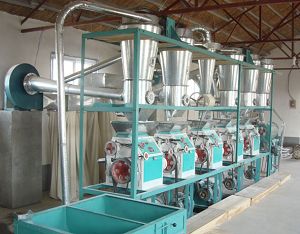Flour can very well be one of the most essential commodities on the market. It is imported and exported in diverse countries across the globe and is used in a variety of applications exceeding the culinary world. Flour is additionally continuously in demand and contains excellent value within the general market. It is namely that, entrepreneurs and businessmen who're planning to invest and set up a new franchise can consider a flour processing plant as being a great opportunity and a potentially profitable business scheme.
If you are planning to set up a basic flour processing plant, you can mill flour that comes directly to you. Manual and automated grain mills for utilization in the kitchen area, which can also be used for milling flour, is available on the market at the commercial friendly price which range from $100 to $700 for example the shipping fee. There are two factors that have effect on the raw material applied for the mill, the noise level during operation as well as their adjustability. Equipment forged from stainless steel is the ideal type of machinery you should opt for this kind of plantation as it is able to run with low noise levels, lower heat generation and less the dust and dirt dispelled in the air. These equipments can also be modified for fine or coarser output which may greatly affect the price. Metal and plastic designed equipment will be more ideal than wood. The recommended rate for milling flour is 40 pounds of good milled flour hourly.
However, if you intend on producing industrial grade flour, you will have to include wheat cleaning and conditioning prior to the actual milling operations. Wheat cleaning generally involves grading of wheat in accordance to specific attributes and mixing some grades to obtain the desired milled flour. There are several types or classifications of wheat, which is divided according to their protein content. This consists of soft, medium hard and hard wheat. The kind of or category of wheat will determine where the ingredient will be best combined with, for example pasta, biscuits or bread. On the other hand, the whole process of wheat cleaning involves adding a regular amount of water and enabling the prepared wheat by sitting for a number of hours. Then, the actual flour milling machine process will start to generate flour, wheat germ and bran. The generated wheat should be packed and usually stored for some time so as to age before it will be shipped and delivered to various establishments, including manufacturers of biscuits, pasta, crackers along with other companies that produce and sell baked items. Other companies you can supply are the ones that use wheat germ and bran to produce breakfast cereals or feeds for animals. If you decide to set up a commercial-scaled franchise or commercial facility, don't be surprised to deal mostly with wheat breeders, traders, suppliers and even end users of flour who are interested in wholesale supplies to keep the cost cheaper. Advanced level milling processes will require more intricate inspections and equipment to be used, including magnetic separator, aspirator and scourer.

No comments:
Post a Comment
Note: Only a member of this blog may post a comment.